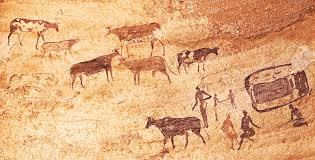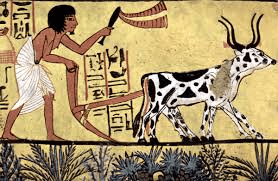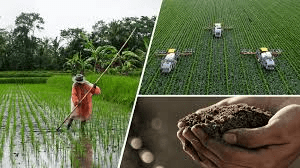Agriculture is one of the oldest and most vital practices known to humanity. It is the backbone of human civilization, providing food, fiber, medicine, and other resources essential for survival and development. Without agriculture, the advancement of society as we know it would not have been possible. This article will explore the fundamental concepts of agriculture, its origins, and how farming techniques have evolved over time.
Agriculture can be defined as the science, art, and practice of cultivating plants and livestock. It encompasses a wide range of activities, including growing crops, raising animals, and managing resources such as water, soil, and land. Agriculture is the foundation of the food supply chain, ensuring that people have access to the necessary nutrients for growth and health.
The term “agriculture” comes from the Latin words “ager,” meaning field, and “cultura,” meaning cultivation. Together, these words capture the essence of agriculture as the cultivation of land to produce food and other products. Agriculture is not just limited to large-scale farming; it also includes small-scale gardening, livestock rearing, and even urban farming practices.
The Origins of Agriculture
The origins of agriculture can be traced back to around 10,000 years ago during the Neolithic Revolution. Before this period, humans lived as hunter-gatherers, relying on wild plants and animals for food. The transition from hunting and gathering to farming marked a significant turning point in human history.
The first known agricultural practices began in the Fertile Crescent, a region in the Middle East that includes parts of modern-day Iraq, Syria, Lebanon, Israel, and Jordan. This area had a favorable climate and rich soil, making it ideal for growing crops. Early humans began to domesticate wild plants and animals, selecting those with desirable traits for cultivation and breeding.
The domestication of plants and animals allowed humans to settle in one place, leading to the development of permanent communities. This shift from a nomadic lifestyle to settled farming communities laid the foundation for the growth of civilizations. Agriculture provided a stable food supply, enabling populations to grow and societies to become more complex.
Early Agricultural Practices

Early agricultural practices were simple and labor-intensive. Farmers relied on basic tools such as digging sticks, hoes, and sickles to plant, tend, and harvest crops. The first crops to be domesticated included wheat, barley, lentils, and peas. These crops were easy to grow and provided a reliable source of food.
In addition to crop cultivation, early farmers also domesticated animals for food, labor, and other purposes. Goats, sheep, cattle, and pigs were among the first animals to be domesticated. These animals provided meat, milk, wool, and other resources, making them valuable assets for early agricultural communities.
One of the key developments in early agriculture was the practice of irrigation. Irrigation involves supplying water to crops through channels, ditches, or other means. This practice allowed farmers to grow crops in areas where natural rainfall was insufficient, leading to increased agricultural productivity.
Another important early agricultural practice was crop rotation. Crop rotation involves planting different crops in the same field in successive seasons to maintain soil fertility and reduce the risk of pests and diseases. This practice helped early farmers to sustain their crops over long periods and improve yields.
The Evolution of Farming Techniques
As human societies grew and became more complex, so did agricultural practices. The evolution of farming techniques has been shaped by various factors, including technological advancements, population growth, and environmental changes. Over time, farmers have developed more efficient and effective methods for cultivating crops and raising animals.
1. The Development of Plows: The invention of the plow was a significant advancement in agricultural technology. The plow allowed farmers to till larger areas of land more efficiently, leading to increased crop production. Early plows were made of wood and were pulled by animals such as oxen or horses. Over time, plows became more advanced, with metal blades and improved designs that made farming even more efficient.
2. The Use of Fertilizers: Fertilizers have played a crucial role in the evolution of farming techniques. Early farmers used natural fertilizers such as animal manure and compost to enrich the soil and improve crop yields. With the advent of industrial agriculture, synthetic fertilizers became widely available, allowing farmers to grow crops more intensively and on a larger scale. However, the overuse of synthetic fertilizers has also led to environmental issues such as soil degradation and water pollution.
3. The Introduction of Crop Varieties: The development of new crop varieties through selective breeding and, more recently, genetic modification, has significantly impacted agriculture. By selecting plants with desirable traits, such as disease resistance, drought tolerance, and high yields, farmers have been able to improve crop performance and adapt to changing environmental conditions. Genetically modified (GM) crops have further expanded the possibilities for agriculture, although they have also sparked debates over their safety and environmental impact.
4. The Mechanization of Agriculture: The mechanization of agriculture has transformed farming into a more efficient and productive industry. The introduction of machinery such as tractors, combine harvesters, and irrigation systems has allowed farmers to cultivate larger areas of land, harvest crops more quickly, and reduce the need for manual labor. Mechanization has also enabled the development of large-scale commercial farming operations, contributing to the global food supply.
5. The Green Revolution: The Green Revolution of the mid-20th century marked a period of significant agricultural advancements. It involved the widespread adoption of high-yielding crop varieties, modern irrigation techniques, and the use of chemical fertilizers and pesticides. The Green Revolution led to dramatic increases in food production, particularly in developing countries, helping to alleviate hunger and improve food security. However, it also raised concerns about the environmental and social impacts of industrialized agriculture.
6. Sustainable Farming Practices: In recent years, there has been a growing emphasis on sustainable farming practices. Sustainable agriculture aims to meet the needs of the present without compromising the ability of future generations to meet their own needs. This approach to farming focuses on minimizing environmental impact, conserving natural resources, and promoting biodiversity. Techniques such as organic farming, agroforestry, and permaculture are examples of sustainable farming practices that seek to balance productivity with environmental stewardship.
7. Precision Agriculture: Precision agriculture is a modern farming technique that uses technology to optimize crop management. By collecting data on soil conditions, weather patterns, and crop health, farmers can make more informed decisions about planting, fertilizing, and harvesting. Precision agriculture tools, such as GPS-guided tractors, drones, and sensors, enable farmers to target specific areas of their fields with precision, reducing waste and increasing efficiency.
Read Also: Trichomoniasis: Description, Damages Caused, Control and Preventive Measures
Agriculture in Ancient Civilizations

Agriculture has been a cornerstone of human development for thousands of years. Ancient civilizations depended on farming to grow their populations and build complex societies. Understanding agriculture in these early cultures helps us appreciate its critical role in shaping the world.
1. The Birth of Agriculture: Agriculture began around 10,000 years ago in the Fertile Crescent, a region in the Middle East. Early humans transitioned from hunting and gathering to farming by cultivating crops like wheat, barley, and legumes. They also domesticated animals such as sheep and goats. This shift allowed people to settle in one place, leading to the creation of villages and, eventually, cities.
2. Ancient Egypt: The ancient Egyptians developed advanced farming techniques along the Nile River. The Nile’s annual floods deposited nutrient-rich silt on the fields, making it possible to grow surplus crops like wheat and barley. Egyptians built irrigation systems to control the water flow and maximize crop yields. Agriculture was so central to their society that it influenced their religion and economy.
3. Mesopotamia: In Mesopotamia, located between the Tigris and Euphrates rivers, early farmers used irrigation to turn arid land into fertile fields. They grew barley, wheat, and legumes and raised livestock. The Sumerians, one of the earliest Mesopotamian cultures, invented the plow and developed early forms of writing to keep track of agricultural goods.
4. Ancient China: Chinese agriculture was highly developed by the time of the Shang Dynasty (1600–1046 BCE). The Chinese grew rice in the south and millet in the north. They also invented sophisticated farming tools, such as the iron plow, and developed techniques like crop rotation to maintain soil fertility.
5. The Inca Empire: The Incas, who lived in the Andes Mountains of South America, adapted their farming practices to the mountainous terrain. They built terraced fields to prevent soil erosion and grew crops like potatoes and quinoa. The Incas also developed irrigation systems and storage methods to ensure food security.
The Agricultural Revolution
The Agricultural Revolution, which began around the 18th century, marked a dramatic shift in farming practices. This period saw the development of new techniques and technologies that greatly increased food production and efficiency.
1. Enclosure Movement: In Britain, the Enclosure Movement involved consolidating small farms into larger, more efficient ones. This allowed for more systematic farming and better crop rotation. The movement also led to the improvement of livestock breeds and the introduction of new crops.
2. Technological Advances: The Agricultural Revolution brought significant technological innovations. For example, the seed drill, invented by Jethro Tull in 1701, allowed for more efficient planting of seeds. The development of new plow designs and mechanical reapers further improved farming productivity.
3. Crop Rotation and Soil Improvement: Farmers began using crop rotation systems to improve soil health and increase yields. The four-field system, which involved rotating between wheat, barley, legumes, and turnips, helped replenish nutrients in the soil. New fertilizers, such as lime and manure, were also introduced to enhance soil fertility.
4. The Role of Science: Advances in scientific knowledge contributed to the Agricultural Revolution. Scientists studied plant and animal breeding, leading to the development of high-yield crop varieties and improved livestock breeds. This scientific approach to farming helped increase food production and support growing populations.
Read Also: Tuberculosis (Mycobacterium bovis): Description, Damages Caused, Control and Preventive Measures
Modern Agriculture

Modern agriculture has evolved significantly from its early beginnings, incorporating advanced technologies and practices to meet the demands of a growing global population.
1. Mechanization: Today’s farms use sophisticated machinery, such as tractors, combine harvesters, and drones, to enhance productivity. These machines make planting, cultivating, and harvesting crops faster and more efficient. Mechanization has transformed agriculture from a labor-intensive activity to a more automated process.
2. Biotechnology: Biotechnology plays a key role in modern agriculture. Genetic modification (GM) and selective breeding have produced crops with improved traits, such as resistance to pests and diseases, and increased yields. GM crops, like Bt cotton and Roundup Ready soybeans, are widely used to boost agricultural productivity.
3. Sustainable Practices: There is a growing emphasis on sustainable farming practices. These practices aim to reduce environmental impact, conserve resources, and promote biodiversity. Techniques such as organic farming, agroforestry, and conservation tillage are used to achieve these goals. Sustainable agriculture seeks to balance productivity with environmental stewardship.
4. Precision Agriculture: Precision agriculture uses technology to optimize farming practices. GPS and data analytics help farmers make informed decisions about planting, watering, and fertilizing. This approach improves efficiency and reduces waste by targeting specific needs of crops and soil.
5. Global Trade: Modern agriculture is closely linked to global trade. Countries export and import agricultural products to meet the demands of their populations and balance supply and demand. Global trade also influences agricultural practices, as farmers adapt to international market trends and regulations.
Agriculture’s Impact on Society and Culture
Agriculture has had a profound impact on human societies and cultures throughout history.
1. Economic Development: Agriculture has been a key driver of economic development. It provides employment for millions of people worldwide and contributes to national economies. Agricultural products, such as grains, fruits, and vegetables, are essential for food security and trade.
2. Social Structure: The rise of agriculture led to the development of complex social structures. Settled farming communities grew into towns and cities, and societies became more stratified. The division of labor and the emergence of specialized roles, such as farmers, artisans, and traders, shaped social hierarchies.
3. Cultural Practices: Agriculture has influenced cultural practices and traditions. Festivals and rituals often celebrate the agricultural cycle, such as harvest festivals and planting ceremonies. Agriculture has also inspired art, literature, and folklore, reflecting its significance in human history.
4. Technological Innovation: The need to improve agricultural productivity has driven technological innovation. From early plows to modern machinery, the development of agricultural tools and techniques has spurred progress in other areas of technology and engineering.
5. Environmental Impact: Agriculture has also had significant environmental impacts. Practices such as deforestation, soil erosion, and overuse of water resources have affected ecosystems and biodiversity. Sustainable agriculture seeks to address these issues and minimize environmental harm.
Conclusion
Agriculture has played a central role in shaping human history and development. From its origins in ancient civilizations to the technological advancements of the modern era, agriculture has been crucial in providing food, supporting economies, and influencing cultures.
Understanding the evolution of agriculture helps us appreciate its importance in our daily lives and recognize the challenges and opportunities it presents. As we face global challenges such as climate change and population growth, agriculture will continue to play a vital role in ensuring food security and sustaining human societies.
By learning from the past and adopting innovative and sustainable practices, we can build a future where agriculture remains a cornerstone of human progress and well-being.
Read Also: How To Raise Chickens – The Simple Secrets To A Great Backyard Flock

